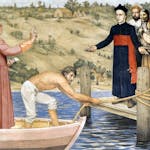When it comes to the new professional soccer stadium in St. Paul's Midway area, no one, it seems, wants to build it and then just wait around to see how they will come. So the work to figure out how to get fans to ditch their cars in favor of other modes has begun.
While St. Paul and Minnesota United officials have repeatedly asserted that as many as half of the fans heading to the stadium will take the bus or train, or will bike or walk, no one really knows for sure how an estimated 20,000 fans per game will get there.
Now a group of University of Minnesota graduate students has started studying how the team, the city and Metro Transit can encourage soccer fans to leave their cars behind when they go to the new stadium, planned for an area near the busy intersection of University and Snelling avenues just north of Interstate 94.
The group is expected to present a series of recommendations in March. The city also is planning a comprehensive transportation study by early summer as part of the redevelopment of the Snelling-Midway area. The study will evaluate the site and potential development expected to spring up around it, said Tonya Tennessen, a spokeswoman for Mayor Chris Coleman.
She added that city officials "will absolutely engage the neighborhood and broader community in conversations about those findings."
How fans will funnel into the area surrounding the stadium is not a minor concern. Neighbors of the privately funded $120 million stadium have repeatedly said that they oppose massive surface parking lots and also that they fear cars will spill over into surrounding neighborhoods.
"We have been hearing from community members that traffic issues and parking issues are of primary concern to them. … Residents have consistently expressed fear about traffic and how it will negatively affect an already-congested area," said Julie Reiter, executive director of the Union Park District Council, which represents several neighborhoods near the stadium site.
How other cities do it
Union Park joined forces with a team of public policy and business students from Common Grounds, an interdisciplinary collaboration at the University of Minnesota, to study how fans in cities from Portland, Ore., to Ottawa get to games and what officials can do to encourage them to leave their cars at home.
"In places where a transit strategy is successful, it is a comprehensive approach," said Simon Cecil, who is leading the graduate student group.
Some teams or cities offer subsidies, discounted game tickets or free transit fares to encourage fans to hop a bus or a train or take a bicycle. Others may provide shuttle service from outlying parking lots.
While there may be no single approach or idea, Cecil said, there is a common goal: Encourage people to use alternative transportation to one of the Twin Cities' most congested areas.
"It is agreed that they want large numbers of people coming by public transit," he said. "The question is going to be: How are they going to do it?"
The proposed stadium's location — along with the fans' younger, urban makeup — makes that goal not so far-fetched, officials say.
Minnesota United spokesman Eric Durkee said the team is open to incentives encouraging fans to use transit. "We are all ears," he said about possible recommendations from Cecil's group.
Durkee added that the Midway site will make the team more accessible to a broader, more urban fan base that is already accustomed to using buses, trains and bikes. As an example, he said, 60 percent of the Portland Timbers soccer team's fans take public transit to games. In a market where one-fourth of Vikings and Twins fans already do that, Durkee said, it shouldn't be hard to get United fans out of their cars.
"I think it's going to happen organically," he said.
The Snelling-University intersection is served by a stop on the Green Line light-rail route connecting Minneapolis and St. Paul. Soon a bus-rapid-transit route down Snelling Avenue will connect Rosedale on the north with the Highland Park neighborhood and the airport to the south and west.
Parking is available nearby for fans who have to drive, and more is scheduled to be built, officials say.
"I think there is ample reason to be optimistic," Tennessen said of high-transit expectations.
James Walsh • 651-925-5041





